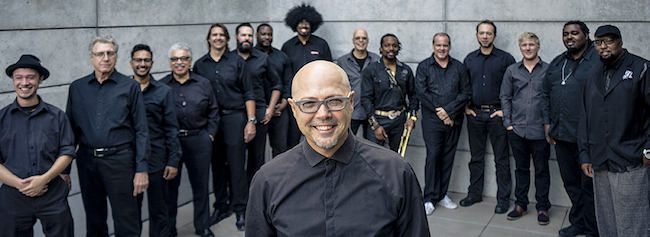Jun 3, 2025 11:25 AM
In Memoriam: Al Foster, 1943–2025
Al Foster, a drummer regarded for his fluency across the bebop, post-bop and funk/fusion lineages of jazz, died May 28…

John Beasley (center) is the leader of MONK’estra. The group performed at the North Sea Jazz Festival on July 7.
(Photo: Courtesy the artist)From the Afro-Cuban re-imagining of “Epistrophy” to a lively rap version of “Brake’s Sake,” Thelonious Monk’s classic tunes were taken for a wild ride by pianist-bandleader John Beasley’s 15-piece MONK’estra big band at the opening night of the North Sea Jazz Festival. It was the first of a rare two-night stand at the jazz party (like last year’s doubleheader of Arturo O’Farrill’s Afro-Latin Jazz Orchestra).
A packed house at the Hudson stage heard Beasley and company take free flight in celebration of the centennial of Monk’s birthday with freshly arranged tunes from last year’s MONK’estra, Vol.1 on Mack Avenue as well as new arrangements on MONK’estra, Vol. 2, scheduled for release Sept. 1.
The band delivered the rhythmically charged ”Gallop’s Gallop,” featuring drummer Peter Erskine, and introduced a rousing version of “Criss-Cross.” But a sure highlight of the evening was a romp through “Skippy,” which Beasley said was the “hardest” tune of the set because “it goes in a lot of different places.” And that it did, with atmospheric trombones, kicking rhythms and feisty sax solos.
Talking between shows, Beasley noted that the tune itself is relatively simple. “Monk used to play [a solo version of] ‘Tea For Two,’ then he recorded it by re-harmonizing the melody and finally wrote another melody over that to make it ‘Skippy,’” he said. “Then I took it from there with my arrangement.”
Beasley talked about the project, noting that he had played Monk before in different settings, including on bassist Buell Neidlinger’s Thelonious album in 1987 and in a duo recording with guitarist Steve Cardenas on 1994’s 10/10 Tribute To Thelonious Monk.
The big band setting almost came as an accident after the arranger found a new toy: the Sibelius music notation software that he was using while serving as the associate music director of the TV show American Idol (for Carrie Underwood in 2003 and lead arranger thereafter for over 10 years).
“After the season ended, I decided to do a 20th-century big band chart using Monk’s ‘Epistrophy,’” he said. “I quickly found out that I could stretch Monk’s form, make stops and starts. I realized how pliable his music was and how open he was to interpretation. Arranging is improvisation, so I went from there.”
He assembled a band of friends to perform this tune and others. After playing the music for a couple years under the name MONK’estra, he invited Monk’s son, T.S. Monk, to come hear the band and give it his blessing.
“T.S. is always protective of his father, but he was totally cool with what we were doing,” he said. “He said, ‘I give you my blessing because the band is the step that my dad wanted for his music. He told me that he wrote his music to be vehicles for self-expression.’”
So, with Beasley’s interpretations of Monk’s unique quirkiness, offbeat actions and punchy dissonances, has he received any detractors?
“I was fully expecting to hear people complaining about ‘’Round Midnight,’ the way I made it electric with a Glasper-esque vibe, but no one has said a thing,” he said. “I think they approve. Really, I think we’re just now catching up with what Monk was doing harmonically. It takes people time to get into different kinds of composing.”
Next up is Vol. 2, with new music and guest spots by Kamasi Washington, Regina Carter and Dianne Reeves, who sings “Ruby, My Dear” (she also guested in MONK’estra’s second show at North Sea, giving voice to the lyrical, moody “Ask Me Now,” to which Beasley had written lyrics). And the shows just keep on coming, including the Detroit International Jazz Festival on Labor Day weekend; the Monterey Jazz Festival on Sept. 17; and a Monk centennial celebration at the Jazz Standard Oct. 12–14. DB

Foster was truly a drummer to the stars, including Miles Davis, Sonny Rollins and Joe Henderson.
Jun 3, 2025 11:25 AM
Al Foster, a drummer regarded for his fluency across the bebop, post-bop and funk/fusion lineages of jazz, died May 28…

“Branford’s playing has steadily improved,” says younger brother Wynton Marsalis. “He’s just gotten more and more serious.”
May 20, 2025 11:58 AM
Branford Marsalis was on the road again. Coffee cup in hand, the saxophonist — sporting a gray hoodie and a look of…

“What did I want more of when I was this age?” Sasha Berliner asks when she’s in her teaching mode.
May 13, 2025 12:39 PM
Part of the jazz vibraphone conversation since her late teens, Sasha Berliner has long come across as a fully formed…

Roscoe Mitchell will receive a Lifetime Achievement award at this year’s Vision Festival.
May 27, 2025 6:21 PM
Arts for Art has announced the full lineup for the 2025 Vision Festival, which will run June 2–7 at Roulette…

Benny Benack III and his quartet took the Midwest Jazz Collective’s route for a test run this spring.
Jun 3, 2025 10:31 AM
The time and labor required to tour is, for many musicians, daunting at best and prohibitive at worst. It’s hardly…